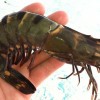Background
What’s an Invasive Species?
Invasive species have arrived in Texas, and they’re making their presence known.
Over the past decade, Texas has seen a large swath of non-native land and aquatic species settle into its lakes, plains, and forests, and the impact on native wildlife and state industry has been drastic. (Executive Order 13112 on Invasive Species defines an invasive species as an alien species whose introduction does or is likely to cause economic or environmental harm or harm to human health.)
Nutria, red fire ants, giant salvinia, and hydrilla are just some of the invaders that residents have become acquainted with in recent years, and some have proved more dangerous than others.

Courtesy of NOAA Great Lakes Environmental Research Laboratory via Flickr Creative Commons
Zebra mussels
The zebra mussel has provoked the most alarm among scientists and aquatic industry representatives. Zebra mussels, for example, have caused alarming declines in fish, birds, and native mussel populations by feeding on phytoplankton, an essential food source for many aquatic species. Originally from the Black and Caspian Seas, these quick-breeding mollusks have recently invaded several Texas lakes, most profoundly Lake Texaoma, and they threaten to take over the Trinity River Basin next. University of North Texas biologists said they found zebra mussels in the Trinity in 2013, the first time the mussels had been found in a Texas river.
Zebra mussels have caused alarming declines in fish, birds, and native mussels by over-absorbing phytoplankton, an essential food source for many aquatic species. Its high rate of filtration also leads to increased sunlight penetration, raising water temperatures and the depth at which that light penetrates the water.
Zebra mussels have also negatively impacted industry. As the mussels have spread, fears have grown that they could do more than hurt props: the invasives could clog vital water intakes for drinking water, power plants and manufacturing. They can adhere to just about any surface, including pipes, boats, boat trailers, buoys and dinghies, and once they do, they’re permanently secured. In several instances, they’ve been reported to have sunk entire buoys and destroyed fishing equipment.
So What Do We Do?
All hope is not lost. Texasinvasives.org, a web-partnership between several state and federal agencies, conservation organizations, green industry, academics, and other private and public stakeholders, has a list of steps residents can take to stop invasive species from spreading.
Food industry spokespersons have offered their own tips for controlling Texas’ growing invasive species population. Andrew Zimmerm, the host of Bizzare Foods on the Travel Channel, has proposed “eat[ing] invasives away.” Texas, he argues, should take note from other countries that have begun serving non-native animals and fish on a plate. Jamaica, for example, has created a whole new culinary market for the Lion Fish, a small, bothersome, but rather tasty invasive fish that’s been known to feed on the babies of native fish. Hunting feral hogs, fishing for Asian carp, and making tiger prawn cocktails are just some homegrown-solutions to Texas’ invasive species problems.



